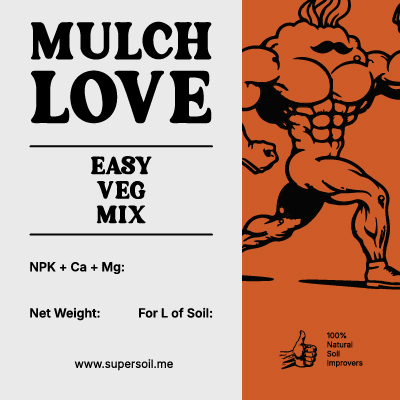Description
Part I:
The Discourse of the Beginning
An Introduction to the Nursery
In the dominant discourse of cultivation, the life of a plant is often treated as a linear, uniform process, to be managed with a single, unvarying soil. This is a profound philosophical error. It is a failure to recognize that the beginning is not merely a smaller version of the end, but a distinct and fragile state of existence. The seedling, the clone, the newly-rooted life—it is in a state of pure potentiality, and to subject it to the full, overwhelming power of a “super soil” is an act of violence. It is, in the Foucauldian sense, a failure of the correct “governmentality.” One does not govern an infant with the same rules as an adult.
This is the philosophy that animates the organic seedling mix. It is not a “weaker” soil; it is a smarter soil. It is an argument, in physical form, for the creation of a specialized environment—a nursery. As the writer Italo Calvino might have described it, this is not the sprawling, chaotic metropolis where the adult plant will later reside; it is the perfectly designed schoolhouse, the cloister, where the young life can gather its strength, establish its foundations, and learn the language of the soil before venturing into the wider world.
This guide will deconstruct the architecture of this nursery. We will examine the precise mineral dialogue that creates its gentle, stable climate. We will explore the nuanced nutrient profile that is designed to whisper encouragement rather than shout commands. And we will understand its crucial role as a preparatory step, a bridge between the sterile fragility of germination and the explosive vigor of full vegetation. This is not just a bag of dirt; it is a curriculum for growth.
Part II: The Architecture of Stability (The Mineral Foundation)
The primary task of the organic veg start mix is not to force growth, but to provide a sanctuary from stress. The mineral components of this mix are the architects of that sanctuary. They do not provide raw power; they provide unwavering stability, creating a perfect, gentle, and forgiving environment for the most delicate stage of life.
The Calcium Trinity: Dolomite Limestone, Chalk & Lithothamnium
For a young plant, the greatest threat is instability. A sudden swing in pH can be a death sentence for tender, developing roots. This trinity of calcium sources—Dolomite, Chalk, and Lithothamnium—forms an unparalleled pH buffering system. They are the soil’s constitutional government, establishing a stable and lasting chemical peace. Unlike bottled pH adjusters that create jarring chemical shocks, these minerals work through a slow, elegant dialogue with the soil. As organic processes naturally create acidity, these compounds gently dissolve, releasing alkaline carbonates to maintain a perfect, steady equilibrium. This is their first function: to remove the grower’s anxiety and the plant’s stress. Their second function is equally vital. They provide a rich, slow-release supply of calcium, the fundamental element for building strong cell walls—the very scaffolding of the new life.
The Infrastructural Duo: Zeolite & Leonardite
With the chemical climate stabilized, the physical and economic infrastructure must be established. Zeolite, the crystalline volcanic mineral, provides the young root system with two critical advantages. First, it is a source of silica, which the plant will absorb to build stronger, more resilient cells, creating a physically tougher seedling. Second, its honeycomb structure provides permanent aeration, ensuring that the roots have constant access to the oxygen they need for explosive development. Leonardite, the ghost of ancient forests, manages the nursery’s economy. Its humic and fulvic acids are the logistical agents that bind to the nutrients in the soil, chelating them and presenting them to the young roots in a form that is effortlessly easy to absorb. They are the teachers, showing the new roots how to feed efficiently.
Part III: The Engine of Emergence (The Nutrient Blend)
The nutritional philosophy of this organic seedling mix is one of nuance and patience. It is designed to nurture potential, not to force a premature and unsustainable explosion of green. The goal is not just to grow a leaf, but to build the engine that will grow all future leaves: the root system.
The Nitrogen Dialogue: Cormorant Guano & Lupin Beans
Nitrogen is the fuel of green growth, but for a seedling, it must be delivered with precision. This mix employs a sophisticated, two-stage nitrogen strategy. The Namibian Cormorant Guano provides a balanced, gentle, and readily available source of NPK. It is the initial spark, the welcome meal that encourages the seedling to emerge and establish itself without the harsh, burning shock of a more aggressive fertilizer. Supporting this initial offering are the Lupin Beans. As a legume, this flour contains a deep reserve of nitrogen in a complex, protein-bound form. This nitrogen is not immediately available. It must be slowly unlocked by the soil’s microbial life, providing a gentle, steady, and continuous feeding over the entire 6-to-8-week vegetative period. It is a dialogue between “hello” and “I am here for you.”
The Root Catalyst: Bat Guano
While many associate bat guano with the phosphorus-driven needs of flowering, its role here is arguably more critical. The single most important objective of the early vegetative stage is the establishment of a massive, complex, and thriving root ball. Phosphorus is the primary element that fuels this specific process. The inclusion of a phosphorus-rich bat guano is a deliberate architectural choice. It is a powerful catalyst for root initiation and development, encouraging the young plant to focus its energy downward, building the vast underground engine that will power the entire future of the plant. A large root system is the foundation of a large harvest, and this is its architect.
Part IV: The Spark of Life (The Role of the Unseen Partner)
The Inoculant: Why Worm Castings are Essential
This Organic Veg Start Mix is a perfectly designed house, but it is delivered empty. The final, critical instruction—to mix it with 10-12% worm castings—is not a suggestion; it is the act of turning the key and turning on the lights. The worm castings are the inoculant. They are the dense, diverse, and vibrant population of beneficial bacteria, fungi, and protozoa that will move into the house and bring it to life.
These microbes are the workforce that will decompose the Lupin Beans, mineralize the guano, and deliver the chelated nutrients from the Leonardite to the roots. They are the living bridge between the potential of the mix and the reality of the plant’s growth. To omit the worm castings is to have a perfectly designed factory with no workers. Their inclusion transforms the bag of ingredients from a simple medium into a true, living organic seedling mix.
Part V: The Grower’s Praxis (Frequently Asked Questions)
Q1: Why can’t I just use the “Organic Complete Mix” for my seedlings?
A: The “Organic Complete Mix” is a powerful, nutrient-dense ecosystem designed to fuel the explosive growth and flowering of a mature plant. For a delicate seedling, this environment is too “hot” or intense. The high concentration of nutrients can overwhelm and burn young roots, a condition known as “nutrient burn.” This Organic Veg Start Mix is specifically calibrated to provide a gentler, more nurturing environment that encourages root development without the stress of excessive nutrition.
Q2: I’ve never used worm castings. What are they and where do I get them?
A: Worm castings (or vermicompost) are the end product of earthworm digestion. They are a rich, microbially active, and perfectly balanced organic amendment. Think of them as the ultimate starter culture for your soil’s food web. You are not just adding nutrients; you are adding life. High-quality worm castings can be purchased from any reputable garden supply store.
Q3: The instructions say this mix is good for 6-8 weeks. What happens after that?
A: This mix contains all the nutrition a plant needs to thrive during its critical early vegetative stage, which typically lasts 6-8 weeks. After this period, the plant will have developed a large, robust root system and will be entering a phase of more aggressive growth. At this point, it will be ready to be transplanted into its final, larger container, which should be filled with the richer, more powerful “Organic Complete Mix” to fuel its flowering stage.
Q4: What is the ideal way to use this mix in my growing timeline?
A: The perfect strategy is to use this mix for an intermediate potting stage. Start your seedling or clone in a small starter plug. Once it has a few sets of leaves, transplant it into a medium-sized pot (e.g., 1-2 gallons) filled with this Organic Veg Start Mix (blended with worm castings). Let it grow for 6-8 weeks. This will allow it to develop a massive root ball that fills the entire pot. Then, just before you switch your lights to a flowering schedule, you will transplant this perfectly prepared, healthy plant into its final, large pot filled with the “Organic Complete Mix.” This “two-step” soil strategy ensures the plant gets exactly what it needs at each critical stage of its life.
Q5: Do I still need to worry about pH and meters with this seedling mix?
A: No. The anxiety of the pH pen is a relic of sterile, chemical-based growing. The “Calcium Trinity” (Dolomite, Chalk, Lithothamnium) in this mix acts as a powerful and automatic pH buffering system. It is designed to hold the soil in the perfect pH range for the entire vegetative period, ensuring your young plants can absorb all the nutrients they need without any stress or intervention from you. Just add water.










There are no reviews yet.